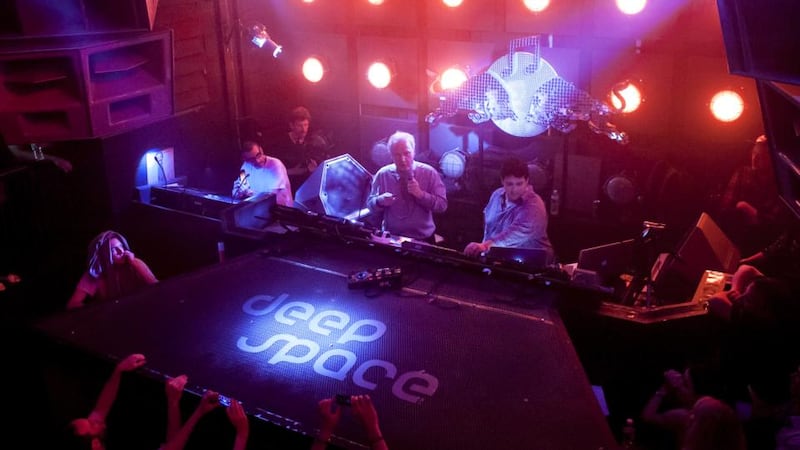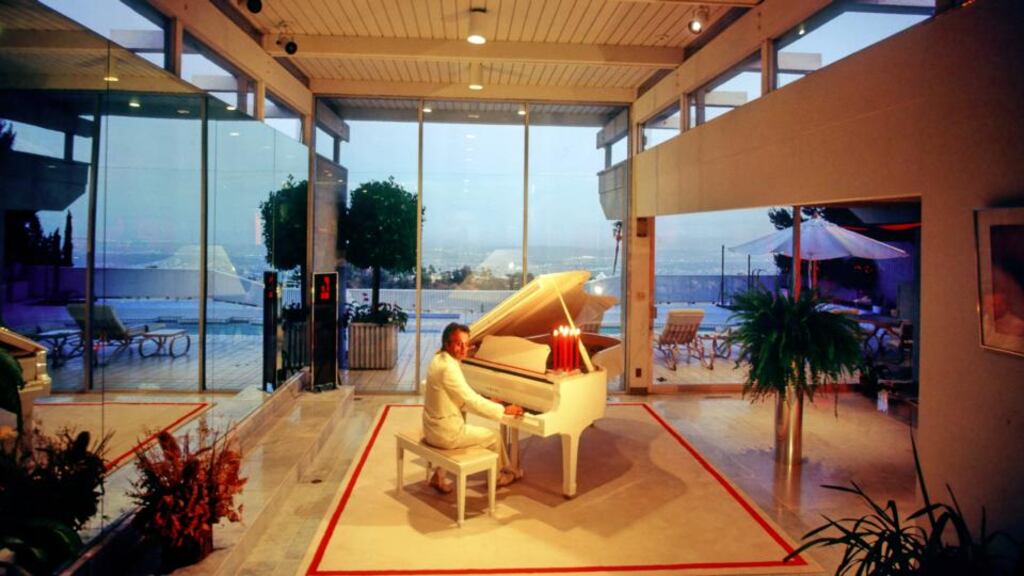Giorgio Moroder knew it was time to think about music again when the pyramid in Dubai was scrapped. But, oh, he says, that pyramid, that would have been quite a sight rising from the sands of the Arabian Desert. He sighs at the thought of what might have been.
"It was the time when they were investing millions and billions in Dubai, and it would have sat quite well with that," he says. "I worked with a famous architect here in California, and it was going to be a giant construction, bigger than anything around it. Maybe the pyramid was a little too big, but I didn't want to compromise. Then the crash came, and all those projects were dumped."
There were other things that might have been. There were ideas for lavish high-tech watches. “I had two totally new ideas which were absolutely great and innovative at the time, and somebody else did them because I didn’t have enough finances or contacts.”

He did get to design a sports car with Marcello Gandini, the designer of the Lamborghini Countach. But only a handful of the duo's Cizeta-Moroder supercars ever drove through the factory gates.
“I made good money and I spent some money,” he says of those lost years when he was out of favour with the music industry. “I suppose I spent time chasing stupid things, but I still loved it. Now, though, I’m back in business and I’m ready to work again. If I have an idea – I don’t have one yet – it’s going to be much easier to find the right people to work on some project. My name is out there again.”
Moroder's name is up in lights thanks to two helmet-wearing Frenchmen. He appears on Giorgio By Giorgio, a spoken-word homage on Daft Punk's most recent album, Random Access Memories. On the track he narrates his life, from growing up in a small German town to his adventures with the Moog synthesiser.
The track is nine minutes long, but even that can't pack in every aspect of a career that stars Donna Summer, Blondie, David Bowie and reels of soundtrack work, including for Flashdance, Top Gun and Midnight Express. Here's a man who has left an indelible electronic mark on the music world.
Daft Punk
The dalliance with Daft Punk – aka Thomas Bangalter and Guy-Manuel de Homem-Christo – seems always likely to have happened, given that he hugely influenced the duo. Listen to his 1977 album From Here to Eternity and it's like listening to the Daft Punk vocoder-and-synths template of today.
The respect is mutual. "One of my all-time favourite tracks is One More Time," he says, referring to their hit from 2000. "I loved the way they treated the voice with the vocoder and the compression. I knew their hits and always thought they were a great band."
The French-Italian summit happened at a restaurant in Los Angeles a few years ago. “They said if they’d an idea for a collaboration that they would contact me. A year later, I was in Paris and they called me and said they had something. They wanted me to come to the studio and just talk and they’d do the rest. So I did that: I spoke for three hours about my life.
“I didn’t hear anything again from them. They are very secretive, as we know. Three months ago they called and played me the song and I was absolutely amazed by how well it sounded.”
It's a far cry from Moroder's earliest recording sessions. "I remember the one for Looky Looky," from 1969. "We were working on a four-track, and it was really tough. We would record all the tracks in stereo and then do overdubs and then do a mix and then put it back on a four-track. It was great, but it was just four tracks to work with. Then it became 16-track, and next the 24-track came along and so on, and it's quite a development."
Back then Moroder’s studio adventures were augmented by musicians, not machines. “The use of musicians in the 1960s and 1970s is what gives those recordings a human touch. I would be in the studio with my favourite musicians. I’d tell them the chords, set the rhythm at 110 and we would play. The keyboard player or drummer would come up an idea and there was quite a lot of collaboration.
“Now a lot of composers and producers do their own programming, and you don’t have that sense of musicians coming together. It was a much better time, because you didn’t have too many choices. Now you have a choice of maybe 1,000 bass drums, and it takes a few hours to find just one.”
But Moroder's own sound owed much to one machine, the synthesiser. A classical composer, Eberhard Schoener, showed Moroder a Moog, and he was smitten. "It sounded so new, so different, so futuristic. I had to work out how to use this in the music I was making."
Lucky streak
He struck gold with Donna Summer. The late American singer was living in Munich and doing session work at his Musicland studio, in the basement of one of the city's hotels. "She had an amazing voice, a fantastic image. To find someone like that, a beautiful, sexy American singer in Munich, was unbelievable. I was very lucky."
That lucky streak produced a string of hits, including I Feel Love, and Moroder was cock of the walk. Film scores followed, Hollywood beckoned and Moroder moved into a mansion he called the Ice Castle, overlooking Los Angeles.
A wild time ensued, with some surreal encounters. "I did the music for one of Slyvester Stallone's films, and he suggested doing a song with Bob Dylan for Rambo III," Moroder says. "I went to his beautiful house in Malibu, and I played it to him and he was a little bit scared. I also don't think he liked the idea of doing a movie with Rambo, which would have been very political with the Russians. There were many meetings like that at the time, always meetings."
For all the work he did, Moroder thinks he could have done better. “I regret that I didn’t have a manager,” he says. “I did my own business stuff, and I didn’t need one, or at least I didn’t think I needed one. It wasn’t good, because you can’t separate out the different parts of a project. You can’t come up with 10 songs for a film and also be the one negotiating the contract.
“Sometimes I got offers from famous groups, and I thought, No, I won’t do that. It’s difficult for a producer to say no, but the manager can come up with great excuses. I made quite a lot of enemies, like some movie directors. I should have had better excuses.”
He might rue missed opportunities, but his music had a huge bearing on electronic music, hip hop, house, dance and pop. When Moroder hears some records today, he could swear he’s listening to his back catalogue.
"I could have done the Drive soundtrack 25 years ago. Obviously, the sounds are much better now than what I had then, but the style is the same. They did a good job just making something retro. Trent Reznor won the Oscar for The Social Network, which is all electronic, too, very like my old records."
Electric Picnic
Now, post-Daft Punk, he's back in clubs and discos, this time as a DJ. "I did a thing for Louis Vuitton in Paris, and I liked that. Then the Red Bull Music Academy asked me to do a DJ gig in New York, and that was very successful. I did another one in Tokyo, and I'll be doing one in Sweden and Ireland. I'll play my own songs, my hits, songs by Donna Summer, songs from the movies, a short version of my song with Daft Punk and some new stuff."
He says he’s got a hunger again to make music. “My curiosity is still intact about my own music and being different. When you listen to American radio 50 per cent of it is dance music – or EDM, as they call it. It’s modern disco music with the same rhythms as before. It is not new.
"If you go back to I Feel Love, I knew it was fresh because no one else was doing that. That's the difference. I cannot tell you what I'm going to do, but I have a great idea of a new kind of trend. It's nice to do something by yourself."
The pyramid in Dubai, you feel, is no longer on the to-do list.
Giorgio Moroder's DJ set is at Electric Picnic on Friday









